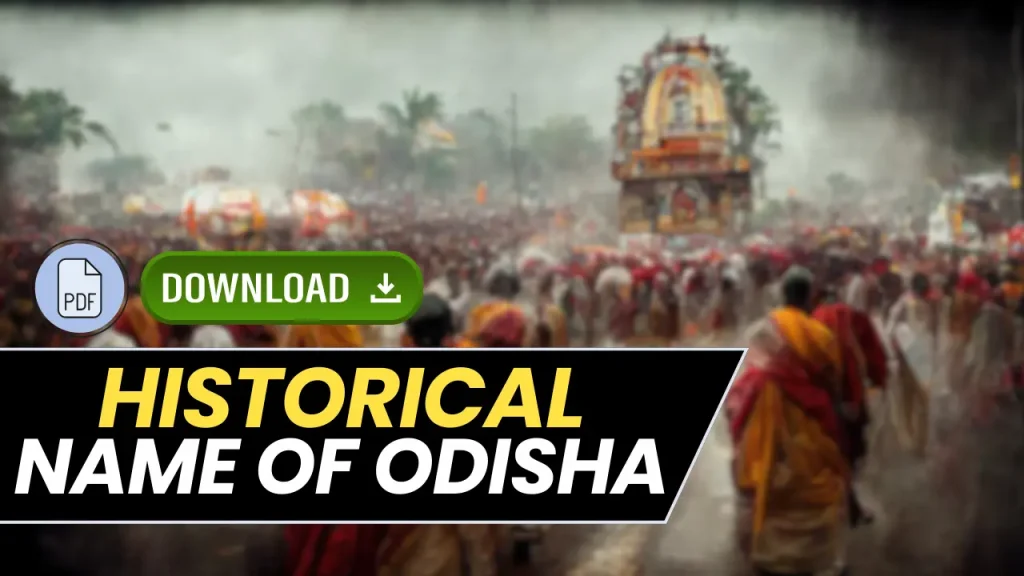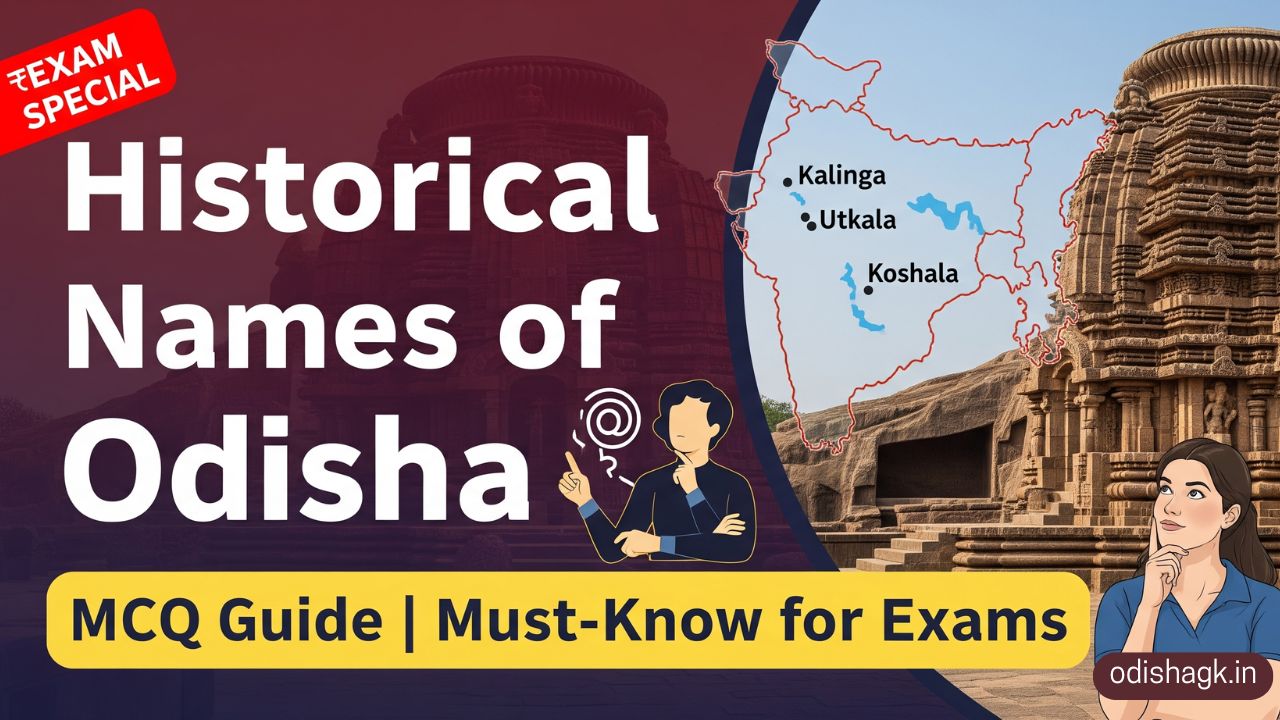Historical Names of Odisha, With Multiple Choice Questions
Dear Aspirant! Here we cover a most Important topic about Odisha General Awareness Historical Names of Odisha which help to your all Odisha competitive exam like OPSC, ASO, OSSC, OSSSC, CT, BED, OTET Exam.
Table of Contents Historical Names of Odisha
Odisha GK with This Comprehensive Book for Just Rs. 29/-
Don’t miss this chance to boost your preparation for Odisha state exams. To help you prepare effectively for these exams, we have launched an all-inclusive Odisha GK book covering all topics from the state. Normally available at Rs. 200, we are offering it at an unbelievable price of just Rs. 29 for a limited period!

Historically, the names of Odisha have been named during the historical period: according to the Kalinga Puranas and the Mahabharata, it was named after Prince Kalinga, King of Bali and Queen Sudarshan.

Odisha, a state with a rich and varied past, has been known by several names throughout history, reflecting its cultural, geographical, and political evolution. These names often originated from ancient tribes, kingdoms, or regional characteristics. Below is a concise overview of the historical names associated with Odisha:
Kalinga: One of the most prominent ancient names, Kalinga refers to a powerful kingdom that encompassed much of present-day Odisha and parts of Andhra Pradesh. It gained fame during the Kalinga War (261 BCE) when Emperor Ashoka of the Maurya dynasty conquered it, later embracing Buddhism due to the war’s immense bloodshed. Ancient texts like the Mahabharata and Greek accounts (e.g., by Ptolemy and Pliny the Elder) mention Kalinga as a formidable maritime and political entity.
Utkala: Meaning “the land of excellence” or “northern extremity,” Utkala was initially a distinct region within the broader Kalinga territory, often linked to northern Odisha. It appears in the Mahabharata and other texts like the Ramayana, signifying its cultural prominence. Over time, Utkala became synonymous with Odisha’s artistic and literary heritage, and it is still celebrated in India’s national anthem, “Jana Gana Mana.”
Odra (or Udra): Derived from the tribe called Odra or Udra, this name likely referred to the coastal regions of Odisha. It appears in ancient Pali texts and inscriptions, such as those from the Gupta period, as “Odra Desha” (land of the Odras). The modern name “Odisha” evolved from this term, reflecting its tribal and linguistic roots.
Tosala (or Tosali): This name is associated with a historical region in central Odisha, notably during the Mauryan era when Tosali served as an administrative center after Ashoka’s conquest. It appears in Ashokan edicts and later texts, indicating a southern division of Kalinga.
Kosala (or South Kosala): Parts of western Odisha were historically linked to the Kosala region, distinct from the northern Kosala of the Ramayana. This name is tied to areas like modern-day Kalahandi and Sambalpur, reflecting their association with neighboring Chhattisgarh.
Mahakantara: Meaning “great forest,” this name appears in Gupta-era inscriptions and likely referred to the dense forest regions of western Odisha, such as Kalahandi and Jeypore.
Oddiyana: Some Buddhist texts mention Oddiyana as a region possibly corresponding to Odisha, though its identification remains debated among scholars. It may reflect Odisha’s early Buddhist influence.
Kamala Mandala: Meaning “lotus region,” this name is found in a 13th-century inscription from Narla in Kalahandi, highlighting the area’s poetic or geographical distinction.
These names illustrate Odisha’s dynamic history, shaped by tribal identities, powerful kingdoms, and shifting boundaries. From Kalinga’s martial glory to Utkala’s cultural richness, each name offers a window into the state’s multifaceted legacy. The transition to “Odisha” (officially adopted in 2011 from “Orissa”) aligns with its ancient Odra roots, pronounced more accurately in the Odia language.
Historical Names of Odisha In Table
| Utkala | According to Mahabharata Utkala was a part of Kalinga. |
| Mahakantara | This name was found during Gupta period. |
| Udra | It was the kingdom which included coastal region of Odisha. |
| Odra | This name was given after Odra tribe. |
| Oddiyana | This name was mentioned in Buddhist texts. |
| KamalaMandala | It was named for the region of Narla in Kalahandi. |
| South Kosala | It was named for the modern day Chhattisgarh andWestern parts of Odisha. |
| Kongoda | This name was found on a copper plate in Ganjam district. |
| Trikalinga | This name was found on copper plates in Sonepur. |
| Tosali | It was named for a city including a subdivision of Kalinga during the Asoka period |
| Odivissa | This name was referred in Buddhist texts for Odisha. |
| Jajnagar | This name was used for Odisha in some texts like Tarikh Nasiri, Tarikh |
What was Odisha known as during the Mahabharata period?
a) Utkala
b) Mahakantara
c) Udra
d) Odra
Answer: a) Utkala
Which historical name of Odisha was mentioned during the Gupta period?
a) Utkala
b) Mahakantara
c) Odra
d) Oddiyana
Answer: b) Mahakantara
Which tribe gave its name to Odisha during ancient times?
a) Utkala
b) Odra
c) Oddiyana
d) Tosali
Answer: b) Odra
In which historical text is Odisha referred to as “Oddiyana”?
a) Ramayana
b) Mahabharata
c) Buddhist texts
d) Gupta period texts
Answer: c) Buddhist texts
What was the name used for the region of Narla in Kalahandi?
a) Utkala
b) KamalaMandala
c) South Kosala
d) Kongoda
Answer: b) KamalaMandala
Which region was named South Kosala, including parts of modern-day Odisha?
a) Coastal region
b) Northern region
c) Eastern region
d) Western region
Answer: d) Western region
Where was the name “Kongoda” found in historical records related to Odisha?
a) Buddhist texts
b) Gupta period texts
c) Copper plate in Ganjam district
d) Copper plates in Sonepur
Answer: c) Copper plate in Ganjam district
In which historical documents was the term “Trikalinga” found?
a) Ramayana
b) Mahabharata
c) Buddhist texts
d) Copper plates in Sonepur
Answer: d) Copper plates in Sonepur
What was “Tosali” named after during the Asoka period?
a) Kingdom
b) City
c) Tribe
d) River
Answer: b) City
Which historical name was used in Buddhist texts for Odisha?
a) Utkala
b) Odivissa
c) Jajnagar
d) Tosali
Answer: b) Odivissa
What was Odisha referred to as in texts like Tarikh Nasiri and Tarikh?
a) Utkala
b) Jajnagar
c) Odivissa
d) Tosali
Answer: b) Jajnagar
According to the Mahabharata, which historical name was a part of Kalinga?
a) Utkala
b) Mahakantara
c) Udra
d) Odra
Answer: c) Udra
Which historical name included the coastal region of Odisha?
a) Utkala
b) Mahakantara
c) Udra
d) Odra
Answer: c) Udra
During which period was the name “Utkala” mentioned?
a) Gupta period
b) Mahabharata period
c) Asoka period
d) Buddhist period
Answer: b) Mahabharata period
Which name was found on a copper plate in the Ganjam district?
a) Kongoda
b) Trikalinga
c) Tosali
d) Jajnagar
Answer: a) Kongoda

